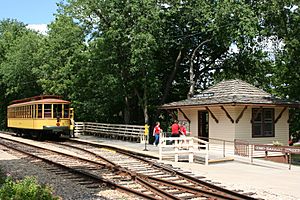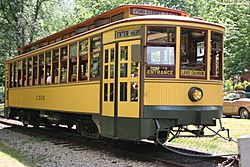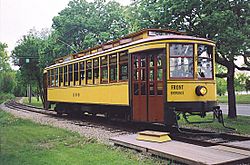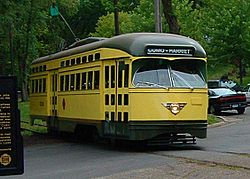Como-Harriet Streetcar Line facts for kids
Quick facts for kids Como-Harriet Streetcar Line (CHSL) |
|
|---|---|

Twin City Rapid Transit No. 1300
|
|
| Overview | |
| Owner | Minnesota Streetcar Museum (cars), Minneapolis (right-of-way) |
| Locale | Minneapolis, Minnesota |
| Termini | Lake Harriet Bde Maka Ska |
| Stations | 3 |
| Service | |
| Type | Heritage streetcar |
| System | Minnesota Streetcar Museum ex-TCRT |
| Operator(s) | Minnesota Streetcar Museum |
| Rolling stock | TCRT and PCC streetcars from old TCRT system |
| History | |
| Opened | August 28, 1971 |
| Technical | |
| Character | right-of-way |
| Track gauge | 4 ft 8 1⁄2 in (1,435 mm) standard gauge |
| Electrification | Overhead lines |
|
Como-Harriet Streetcar Line and Trolley
|
|
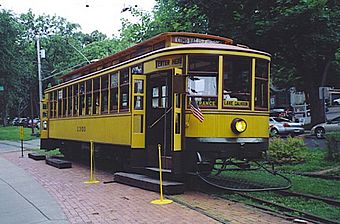
Twin City Rapid Transit No. 1300
|
|
| Location | Minneapolis, MN |
|---|---|
| Built | 1898 |
| Architect | Minneapolis Street Railway Co.; Twin City Rapid Transit |
| NRHP reference No. | 77000739 |
| Added to NRHP | October 17, 1977 |
The Como-Harriet Streetcar Line (CHSL) is a special historic streetcar line in Minneapolis, Minnesota. It follows the original path that streetcars used to take between Lake Harriet and Bde Maka Ska. The Minnesota Streetcar Museum operates this fun line today. It was first started in the 1970s by the Minnesota Transportation Museum. Later, the streetcar part became its own museum.
Contents
History of the Heritage Line
When the Twin City Rapid Transit Company stopped running streetcars in 1954, they gave away some of their old wooden cars. One car, called TCRT No. 1300, went to a group of train fans. This group was called the Minnesota Railfans Association. Car No. 1300 was kept outside for a while.
In 1962, the Minnesota Transportation Museum got the car. They started to fix it up. By 1963, the streetcar was working again! At first, it only made short trips. These trips were on tracks at a roundhouse in St. Paul. The Minnesota Transfer Railway owned these tracks.
There were no electric lines overhead at this spot. So, the streetcar needed a special electric generator. This generator was pulled behind the car. Even with these challenges, people loved riding the streetcar.
Starting Regular Rides
Because so many people were interested, the museum looked for ways to run No. 1300 regularly. The City of Minneapolis and the Minneapolis Park and Recreation Board owned the old streetcar path. This path ran between Lake Harriet and Lakewood Cemetery. In 1970, the museum was able to rent this land.
On August 28, 1971, public rides began. New tracks were laid, and a small building for the streetcars was built. This building was under the Queen Avenue Bridge. The streetcar still used the generator at first. The overhead electric system was finished in 1973.
The historic line became very popular. The museum was able to grow its track from one city block to over a mile. By 2005, the tracks needed repairs from all the use. A big project helped rebuild the tracks. Over time, the museum got and fixed up more streetcars. Today, you can see three different streetcars running on the Como-Harriet line. Usually, one or two run at a time. This line is even listed as a historic place.
Linden Hills Station
The first streetcar station at Linden Hills was built in 1900. It was one block north of Queen Avenue and 42nd Street. The Twin City Rapid Transit Company wanted Lake Harriet to be a fun place to visit. They hoped this would make more people ride the streetcars. They built the original Lake Harriet Bandshell. They also started having concerts at the lake.
More people came to the lake, so a bigger station was needed. In 1914, a larger, chalet-style building replaced the first one. The old building was moved closer to the lake and used for other things. The chalet station stayed until 1954. That's when streetcar operations stopped, and the station was torn down.
When the Minnesota Transportation Museum started building the historic line, only the concrete platform remained. In 1990, the museum built a new station. It looks like the smaller, original Linden Hills Station. Today, you can buy tokens to ride the streetcars here. You can also find souvenirs and learn about Twin City Lines history.
The Streetcars (Rolling Stock)
"Rolling stock" is a fancy way to say the vehicles that run on the tracks. On this line, it means the streetcars themselves!
TCRT No. 1300
The first streetcar the museum ran was Twin City Rapid Transit Company streetcar No. 1300. This car looks a lot like it did from the 1930s to the 1950s. It was built in 1908 by Twin City Rapid Transit. It was designed to be a fast interurban streetcar, reaching speeds of about 35 miles per hour. When it was new, TCRT No. 1300 often ran on the original Como-Harriet route.
In 2003, TCRT No. 1300 had a big update. Its inside wiring, outside, and wood and steel parts were all fixed. This was done to get it ready for its 100th birthday in 2008.
DSR No. 265
Other streetcars were added later. One streetcar used to run in Duluth. It was put into service on the Como-Harriet line in 1982. This was after nine years of hard work to fix it up. It was first built in 1915 by TCRT as No. 1791. But it was sold to Duluth the next year. It ran there until Duluth's streetcar system closed in 1939.
Then, the car was sold again. It was turned into a summer cabin in Solon Springs, Wisconsin. This was a common thing to happen to old wooden streetcars. Many were burned when streetcar lines closed. The inside of this car was removed. So, important parts like the railroad trucks, electric wires, and other pieces had to be found from other old streetcars or built from scratch.
TCRT PCC No. 322
The Twin City Rapid Transit Company built most of its own streetcars. They had their own shops for this. But in the late 1940s, they bought some faster, more modern streetcars. These were called streamlined vehicles. They wanted to compete better with the growing popularity of the automobile.
TCRT No. 322 was a special type called a Presidents' Conference Committee, or PCC streetcar. It was built by the St. Louis Car Company in 1946. It ran in the Twin Cities for a while. Then, in 1953, it was sold to a company in New Jersey. It was one of thirty streetcars bought for use in the Newark City Subway. Later, in 1978, it was sold to the Shaker Heights Rapid Transit in Cleveland, Ohio. The museum got the car in 1990. It took ten years to fix it up. It started running in 2000.


